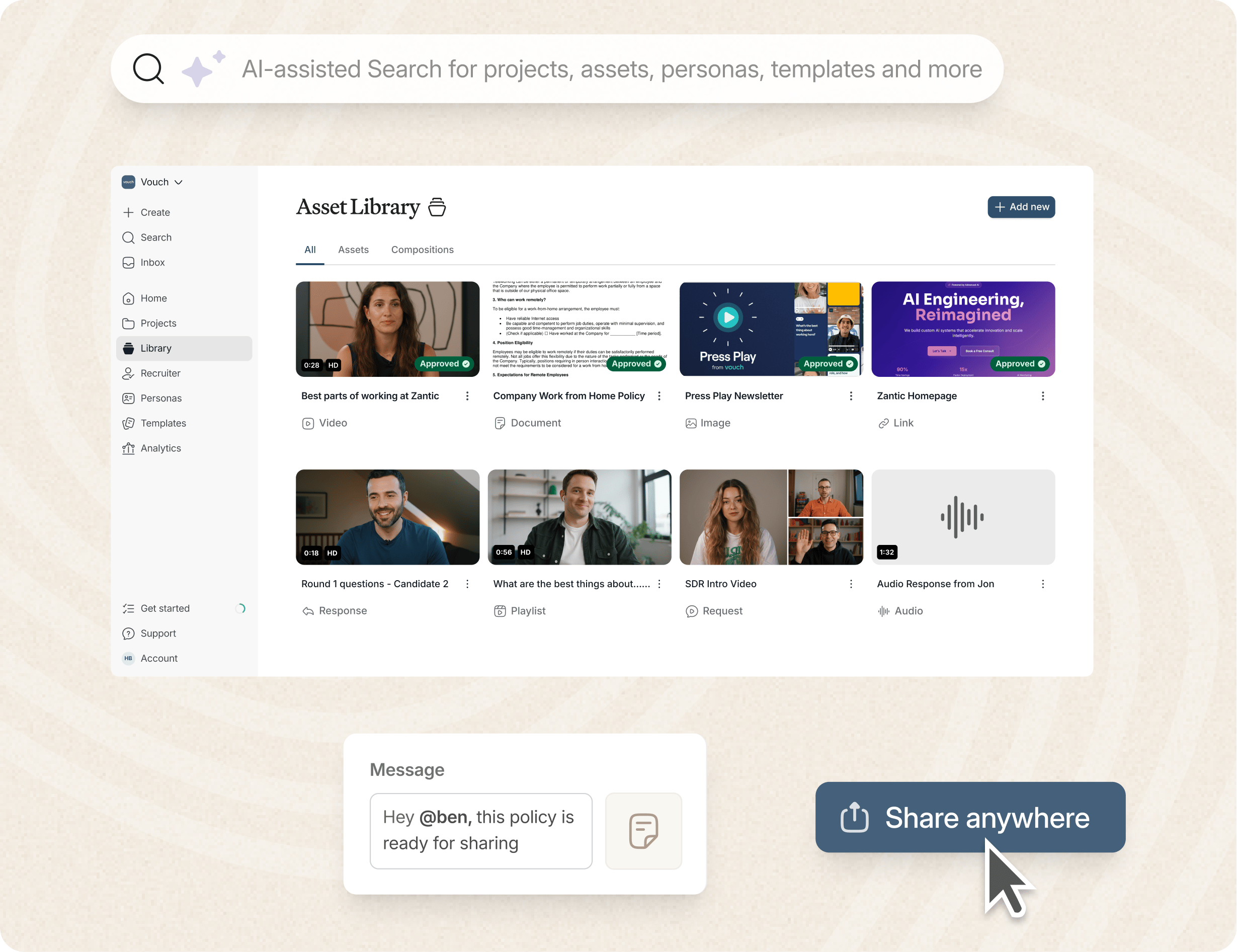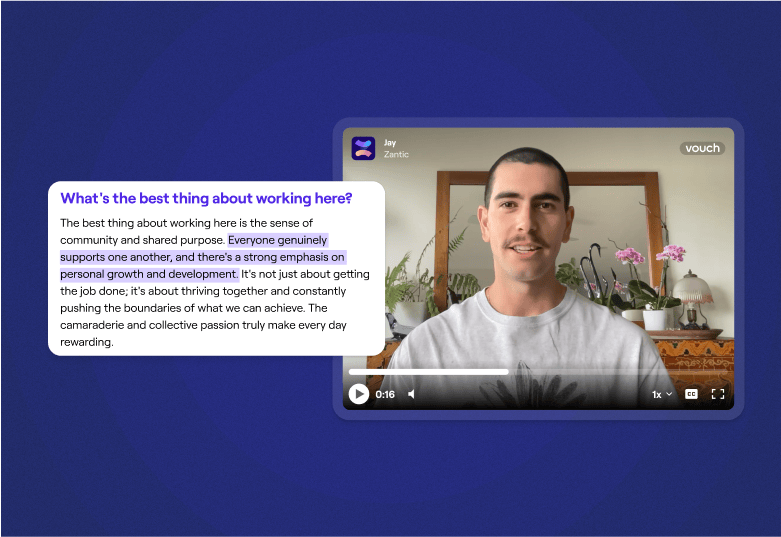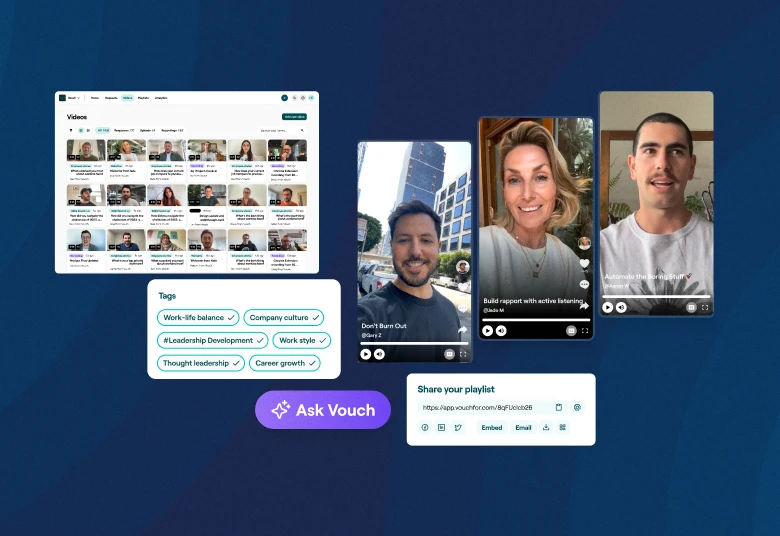If your employee engagement is down, then it is likely your business's potential is down, too.
Employee engagement is everything when it comes to productivity and collaboration, ensuring your business is operating at its full potential. In this article, we look at some proven ideas and employee engagement models that can turn entire companies around.
Modern software tools like Vouch can help significantly, too, especially when it comes to gathering employee feedback, providing team updates, training staff, and more. Be sure to have a look at Vouch, which is loved by teams like Canva, Nike, Cisco, HubSpot, Amazon, and more.
So let's get started.
What Are The 7 Benefits of Using An Employee Engagement Model?
Employee engagement models are researched, tested, and proven ways to get the most out of your teams. Many larger companies use an engagement model to keep a pulse on how their employees are performing, from the very first day of onboarding to retirement.
In addition to these engagement models, it's also worth working on your employer brand if you think motivation, attitude, and productivity are down.
Your employer brand can often trump any specific engagement model, as it creates a "personality" for your business that draws people in and makes them want to be part of something amazing. Employer branding is also the key to talent acquisition.
Here's a breakdown of the benefits:
1. Increased Productivity
Engaged employees are often more motivated and committed to their work, leading to higher productivity levels and thought, which is what the highest-performing teams have.
2. Improved Employee Retention
Engaged employees are more likely to stay with the organization, reducing turnover costs and also ensuring that knowledge is kept in your business and can be built on, not lost.
3. Enhanced Customer Satisfaction
Engaged employees tend to provide better customer service, leading to higher customer satisfaction levels. This is also another area that knowing your employer brand can drastically help.
4. Innovation and Creativity
Engaged employees are more likely to contribute new ideas and solutions, fostering innovation within your company. This is vital for tech companies and any business that is changing with AI or other means.
5. Better Employee Health and Well-being
Engaged employees are generally happier and experience less stress, leading to improved overall health and well-being.
6. Stronger Company Culture
In 2026, your company culture is vital. Creating a positive company culture can help you attract top talent and improve employee morale, which is the key to everything.
7. Higher Profitability
At the end of the day, growing your company and profits is likely not an option. Companies with engaged employees often see higher profitability due to increased productivity, customer satisfaction, and vast increases in innovation.
Let's now jump into the engagement models.
The AI-enabled workspace for talent teams.
- Unified workspace for talent teams
- Accelerate hiring with AI tools
- Auto-generate polished hiring and employer brand content
- Easily repurpose assets across all channel

The Gallup Q12 Engagement Model
Kind of a combination of all other models, the Gallup Q12 engagement model is a globally recognized model that measures employee engagement over twelve key areass. By implementing this model, you can identify areas of improvement, too, which is the very first step for high-productivity teams.
The Gallup Q12 Engagement Model was developed by Gallup, a research-based management consulting company, in the late 1990s. It is designed to measure employee engagement based on twelve key elements, which we discuss below.
The 12 Elements of the Gallup Q12 Engagement Model:
1. Clear Expectations
By setting clear expectations, organizations enable effective client communication and provide employees with a sense of direction.
2. Resources and Materials
This means providing employees with the necessary resources and materials allows them to perform their tasks efficiently and effectively. It's also where video can drastically help.
3. Recognition and Appreciation
Recognizing and appreciating employees' efforts will always lead to a more positive work environment. You just need to be sincere and really care. There is no room for faking it here.
4. Professional Growth Opportunities
Professional growth opportunities enhance employee skills and knowledge and make them feel valuable and empowered. The investment in your employees will lead to their investment in you.
5. Personal Connection with Colleagues
Promoting relationships among employees can be fun and highly rewarding. One way to get the ball rolling is by implementing employee spotlight questions that you can share with the wider team. These work great for starting conversations and before any team events.
6. Feedback and Performance Evaluation
Most companies already provide regular feedback and performance evaluations, which is a key part of the Gallup Q12 Engagement Model.
7. Job Autonomy
Job autonomy empowers your employees by letting them take ownership of their work. We know that many companies are cautious of this, and of course it depends on your industry, but the results can be astounding.
8. Work-Life Balance
In 2026, work-life balance is vital to supporting employee well-being and satisfaction, leading to increased engagement and often employees becoming advocates for your company, the golden spot!
9. Flexible Work Arrangements
Like work-life balance, providing flexible work arrangements like WFH demonstrates trust and understanding while promoting employee satisfaction and commitment.
10. Opportunities for Social Impact
If your company has a social responsibility plan, there is no reason not to get your employees involved. When you and they contribute to causes they care about, their sense of purpose goes through the roof.
11. Leadership Support
Transparent, supportive leadership support is crucial for helping employees feel valued, supported, and motivated to do their best work.
12. Aligning Individual Goals with Organizational Goals
Aligning individual goals with your company's goals creates a sense of purpose and direction, increasing the chances of employees being all-in, and it also helps you build your employer brand for attracting new talent.
The Gallup Q12 engagement model is a broad one, but with all of these 12 factors taken into consideration, you can be sure of more engaged and productive teams.
The Hackman and Oldham Job Characteristics Model
The Hackman and Oldham Job Characteristics Model was developed by J. Richard Hackman and Greg R. Oldham in the 1970s. Hackman and Oldham proposed that there are five core job characteristics: skill variety, task identity, task significance, autonomy, and feedback.
The Hackman and Oldham Job Characteristics Model is a framework that focuses on designing jobs to promote employee engagement at all levels, with five core job characteristics that build employee engagement. Here are the 5 key elements of this much-loved model.
1. Skill Variety
Jobs that require a variety of skills and abilities often enable employees to experience a sense of challenge and growth. If you can and the employee is willing, moving employees around within your company can lead to better employee engagement and better contingency.
2. Task Identity
When employees are tasked with a project or outcomes, letting them take ownership can create a sense of satisfaction that very few other strategies can do.
3. Task Significance
When an employee is given a task that impacts the organization, your customers, or another area of your business in a significant way, the sense of purpose and meaning as an employee is skyrocketed.
4. Autonomy
Providing employees with autonomy, a level of decision-making, and accountability leads to heightened engagement. The same strategy can be used in teams, too.
5. Feedback
Regular feedback on performance allows employees to assess their progress, make improvements, and help you make sure that they feel valued in your company.
The Hackman and Oldham Job Characteristics Model is quite simple but highly effective, which is key to increased productivity within your entire company.
The Servant Leadership Model
The servant leadership model works by serving others rather than the accumulation of power in the leader's self-interest. This model was popularized by Robert K. Greenleaf in the 1970s through his writings, particularly in his essay "The Servant as Leader."
In servant leadership, the leader's primary role is to serve their team members and create a more ethical and caring work environment. This ultimately leads to better performance and employee satisfaction.
Here are the fundamental principles of servant leadership include:
1. Listening
Servant leaders actively listen to their team members' needs and concerns, showing empathy and understanding.
2. Empathy
Servant leaders strive to understand and empathize with others, recognizing the unique perspectives and experiences of each individual.
3. Healing
Servant leaders seek to promote healing and wholeness within their teams, creating a supportive environment where team members can thrive.
4. Awareness
Servant leaders are self-aware and mindful of their impact on others, constantly seeking to improve themselves and their leadership style.
5. Persuasion
Instead of relying on authority or coercion, servant leaders use persuasion and collaboration to achieve goals, valuing input from team members.
6. Conceptualization
Servant leaders have a long-term perspective and can envision the future, helping to shape the organization's goals and strategies.
7. Foresight
Servant leaders anticipate the consequences of their decisions and actions, taking proactive steps to address potential challenges.
8. Stewardship
Servant leaders view themselves as stewards of their organization's resources, working to ensure the well-being of both the organization and its members.
9. Commitment to the Growth of Others
Servant leaders are committed to the personal and professional growth of their team members and support them in their development.
Overall, the servant leadership model emphasizes humility, empathy, and a focus on others, with the belief that this approach can lead to more effective and ethical leadership.
The Appreciative Inquiry Model
The Appreciative Inquiry (AI ...but not that AI:) model is a philosophy model that focuses on identifying and amplifying your company's strengths and successes. Developed by David Cooperrider and Suresh Srivastva in the 1980s, AI is based on the premise that organizations will always grow and evolve in the direction of what they focus on. It's a powerful thought that works.
The appreciative inquiry model is typically conducted in a four-stage process known as the 4-D cycle:
1. Discovery
This stage involves identifying and appreciating the organization's strengths, successes, and positive experiences. It often includes interviews, and surveys with the help of tools such as Vouch, and other methods to gather stories and insights from employees at all levels.
2. Dream
In this stage, participants envision the organization's future based on the positive aspects identified in the discovery phase. They imagine what the organization could be at its best and articulate ambitious yet achievable goals.
3. Design
Participants in this stage develop concrete plans and strategies to achieve the goals and vision identified in the dream phase. This may involve brainstorming, prioritizing ideas, and creating action plans.
4. Destiny (or Delivery)
The final stage involves implementing the plans developed in the design phase. This includes taking action, monitoring progress, and making adjustments as needed to achieve the desired outcomes.
Overall, the appreciative inquiry model is a positive and strengths-based approach that seeks to build on what is already working well within your company, and it's a model that we love at Vouch!
The Self-Determination Theory Model
The Self-Determination Theory (SDT) is a framework for a deeper understanding of human motivation, developed by psychologists Edward L. Deci and Richard M. Ryan in the 1970s and 1980s. SDT proposes that people are inherently motivated to grow, change, and develop their potential. The theory suggests that three innate psychological needs influence motivation and behavior.
Here are the 3 keys to the self-determination theory
1. Autonomy
The need to feel in control of one's actions and choices and to act in accordance with one's values and interests.
2. Competence
The need to feel capable and effective in one's interactions with the environment and to experience mastery and growth.
3. Relatedness
They need to feel connected to others, care for and be cared for by others, and experience a sense of belongingness.
According to SDT, when these needs are met, individuals experience greater motivation, well-being, and psychological growth. Conversely, when these needs are thwarted, individuals may experience reduced motivation and psychological distress, the opposite of what you need in a high-performing team.
How Do You Choose the Right Engagement Model for Your Team?
This is probably the most challenging question of all! At Vouch, we love the Appreciative Inquiry Model because it lets us dream big, but we are a smaller team, so it is easier to implement.
Partly why the Gallup Q12 engagement model is so popular, and also one of the more modern models, is that it takes almost all other models into account. So, if you are not sure, we can suggest the Gallup Q12 engagement model as a great place to start.
In all cases, it's essential to:
1. Understand Your Team's Needs
Start by assessing your team's unique needs and challenges. This will help you narrow down the model that is right for you.
2. Align With Your Team's Objectives
Selecting the engagement model that aligns with your team's objectives is everything.
3. Consider The Implementation Feasibility
Assess the feasibility of implementing the chosen engagement model within your company; naturally, the simpler, the better when you have limited resources.
By carefully evaluating your needs and these models, you can make an informed decision that will effectively drive engagement within your team and contribute to its long-term growth.
How Do You Know Your Chosen Engagement Model Is Working?
To determine if your chosen engagement model is working, you can consider several key indicators and metrics to monitor and analyze. Here are the key factors to monitor.
1. Employee Feedback
Gathering feedback directly from employees through focus groups, one-on-one interviews, or with modern video tools like Vouch can provide valuable insights into the effectiveness of your engagement model.
2. Retention Rates
Monitoring employee turnover rates can indicate whether employees are engaged and satisfied with their work. A decrease in turnover rates may suggest that your engagement efforts are working.
3. Productivity and Performance Metrics
Tracking productivity and performance metrics, such as sales numbers, project completion rates, and customer satisfaction scores, can help assess the impact of your employee engagement model.
4. Quality of Work
Monitoring the quality of work produced by employees can help assess whether they are engaged and motivated to perform at their best.
5. You Company Culture
Assessing your overall company culture and whether it aligns with the goals of your engagement model can help determine its effectiveness.
FAQ
What is employee engagement?
Employee engagement refers to the level of commitment, involvement, and satisfaction that your employees have towards their work and your company.
Why is employee engagement critical?
Employee engagement is crucial for the success of growing teams as it leads to higher job satisfaction, increased productivity, and improved employee retention.
How can you improve your customer retention strategies?
Organizations can focus on customer retention by providing excellent customer service, building solid relationships with customers, and offering loyalty programs or incentives.
What is the Gallup Q12 engagement model?
The Gallup Q12 engagement model is a widely recognized and validated model that measures employee engagement based on twelve key elements, including effective client communication, stakeholder engagement methods, and customer satisfaction strategies.
What is the Hackman and Oldham Job Characteristics Model?
The Hackman and Oldham Job Characteristics Model focuses on designing jobs that promote employee engagement and satisfaction by incorporating five core job characteristics: skill variety, task identity, task significance, autonomy, and feedback.
What is the Servant Leadership Model?
The Servant Leadership Model emphasizes leaders who prioritize the growth and well-being of their employees through relationship-building strategies, effective client communication, and creating a supportive work environment.
What is the Appreciative Inquiry Model?
The Appreciative Inquiry Model is a positive approach to employee engagement that focuses on identifying and building upon strengths and successes within an organization through relationship-building strategies and best engagement practices.
What is the Self-Determination Theory Model?
The Self-Determination Theory Model emphasizes the importance of autonomy, competence, and relatedness in promoting employee engagement by implementing interactive engagement techniques, facilitating effective client communication, and providing growth opportunities.
How do you choose the right engagement model for your team?
To choose the right engagement model, consider your team's needs, goals, and organizational culture. Evaluate different client engagement strategies, stakeholder engagement methods, and best engagement practices offered by each model.
How do you implement engagement models for lasting success?
To implement engagement models successfully, assess the current state of employee engagement, identify areas of improvement, create a plan, monitor progress, collect feedback, and make necessary adjustments to optimize effectiveness.
Why are best engagement practices important?
Best engagement practices are important as they provide proven strategies and techniques that have been successful in fostering employee engagement, satisfaction, and long-term organizational success.
Conclusion
Employee engagement is a critical factor for every company, and these models are a great starting place.
By implementing these strategies, you can boost team productivity and create a positive workplace culture that leads to long-term company success and employee satisfaction.
Just remember that with any engagement model, you need to measure and improve at all times; it's not a one-shot process. Also, keep in mind that tools like Vouch can help you get the most out of your chosen engagement model, so be sure to use them where you can.
See How Vouch Drives Employee Engagement!
Loved by companies like Canva, Nike, Cisco, HubSpot, Amazon, and more, tools like Vouch make leveraging video in your business remarkably easy.
Be sure to book a Vouch demo today and chat with a video content expert.
You might also like

Elevate Your Brand Today With Vouch
Discover how Vouch can accelerate talent acquisition while helping you stay on-brand.






